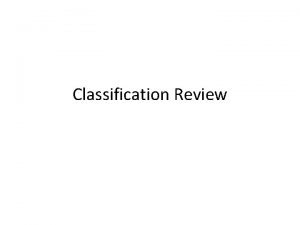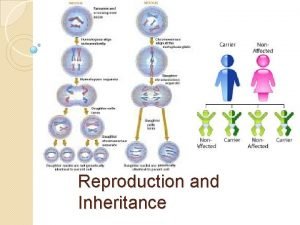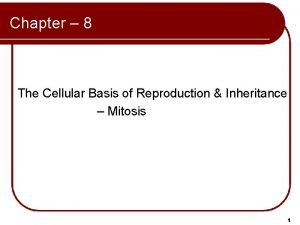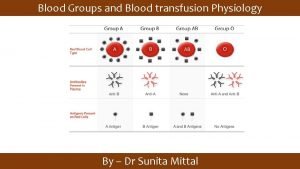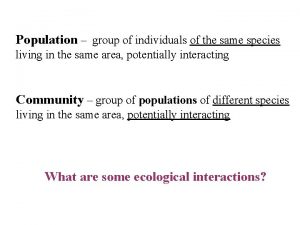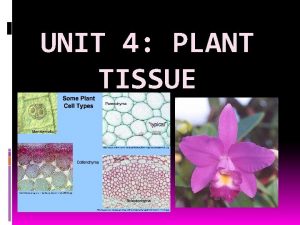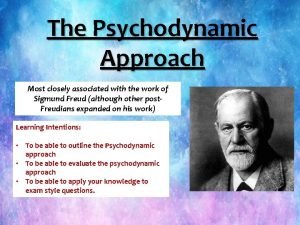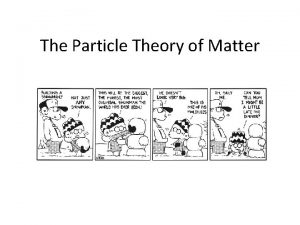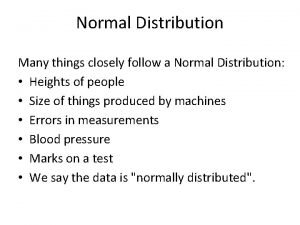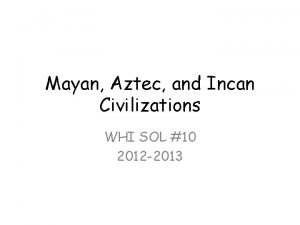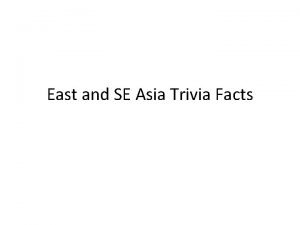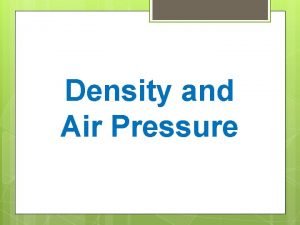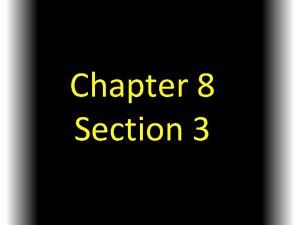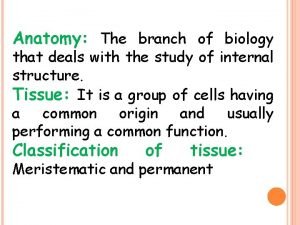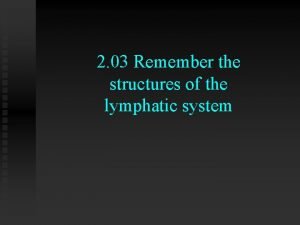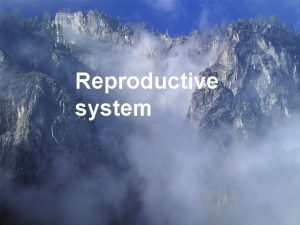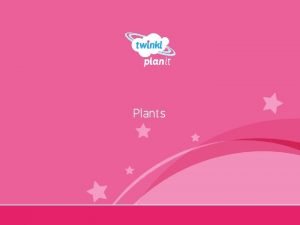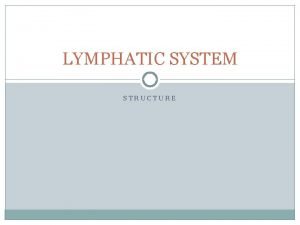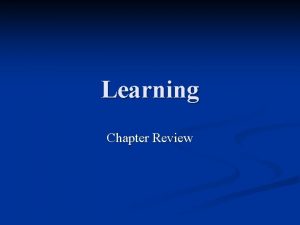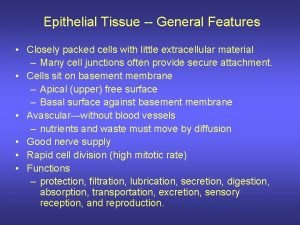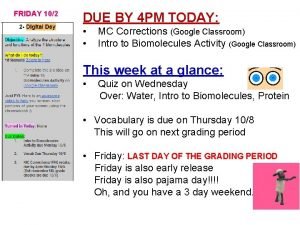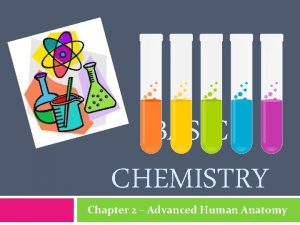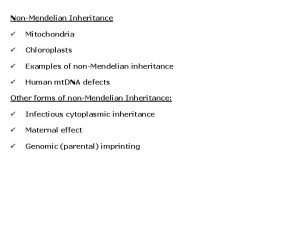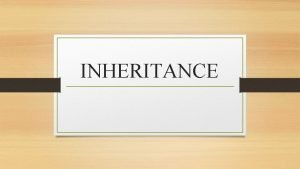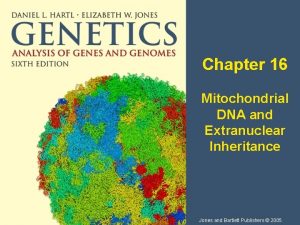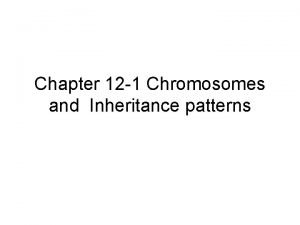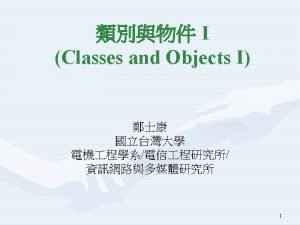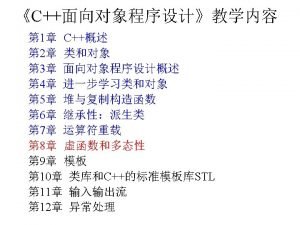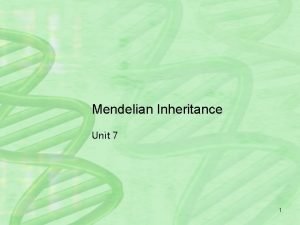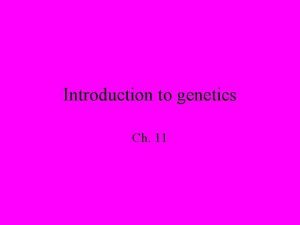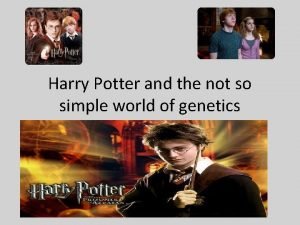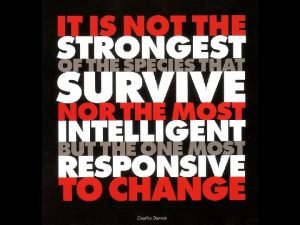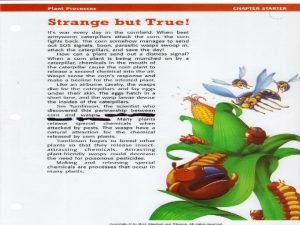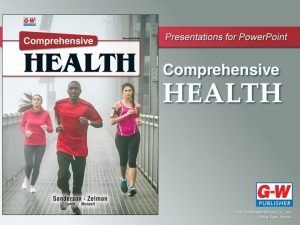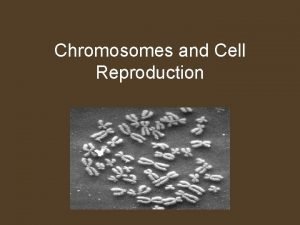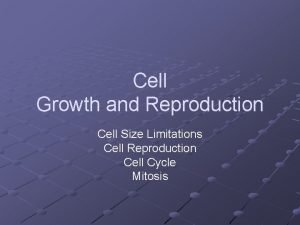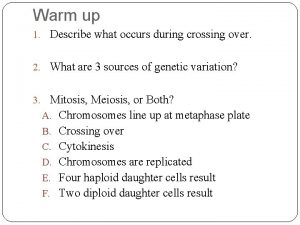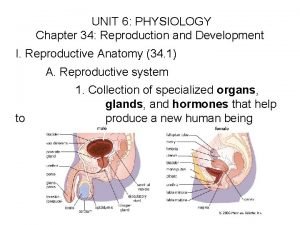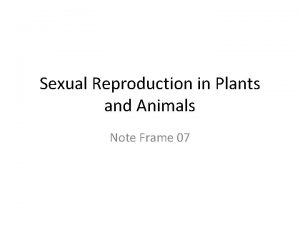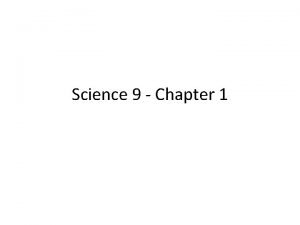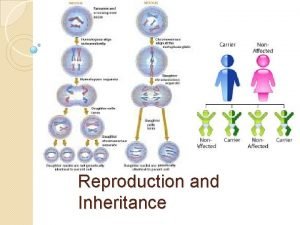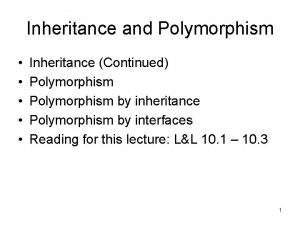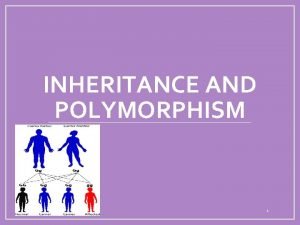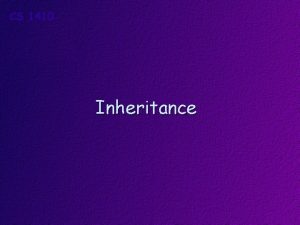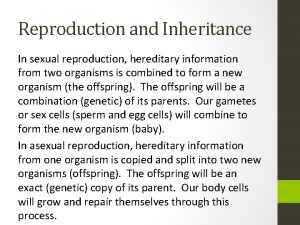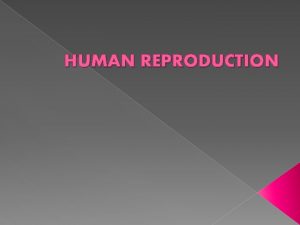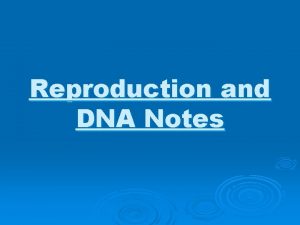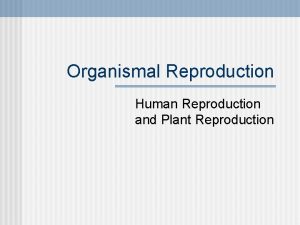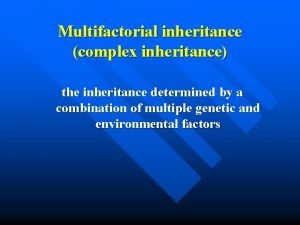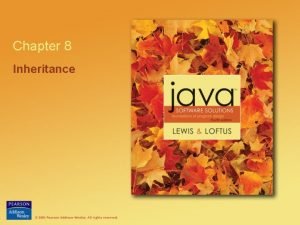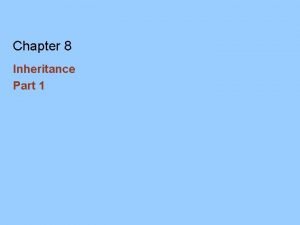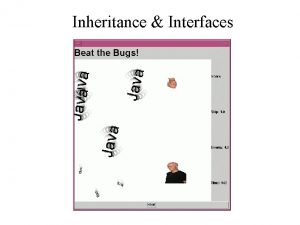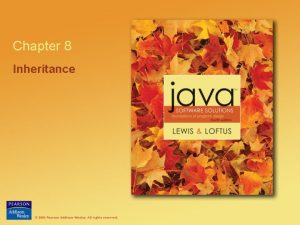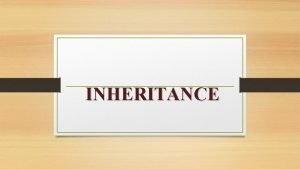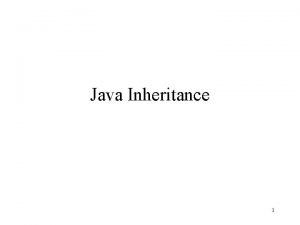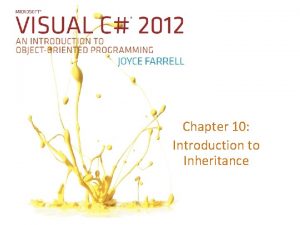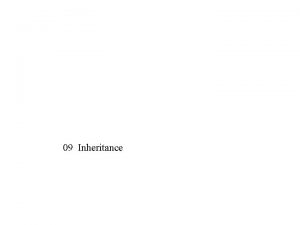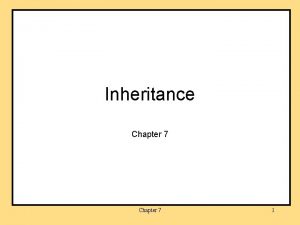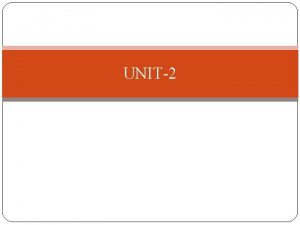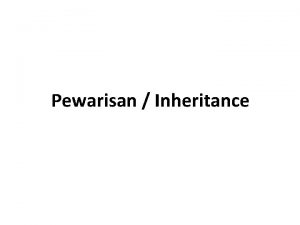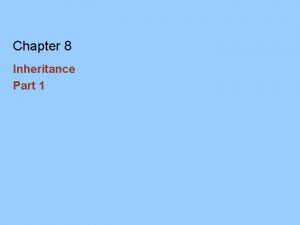Reproduction and Inheritance Overview Species group of closely

































































- Slides: 65

Reproduction and Inheritance

Overview �Species = group of closely related organisms that share certain characteristics and can produce new individuals through reproduction �For any species to survive, they must reproduce �All individuals will die but their species will live on through reproduction �Offspring begins a period of development that ends in adulthood �Once an individual reaches adulthood, it is usually able to reproduce and continue the species

Types of Reproduction �There are two methods of reproduction: ◦ Asexual ◦ Sexual �Asexual reproduction involves just one parent ◦ Results in one or more offspring that are genetically identical to the parent

Types of Reproduction �Sexual reproduction involves two parents ◦ Some genetic material (DNA) comes from each parent ◦ The result is an organism that may be similar to one or both parents but is not identical to either

Asexual Reproduction �Organisms that reproduce asexually produce offspring in a variety of ways. ◦ Some just divide in two: produces two new individuals �The parent becomes an offspring �Eg: Ameba divides into two ameba ◦ Some organisms produce special cells that have a complete set of genetic information �These parts develop into new cells

Asexual Reproduction ◦ Others produce an outgrowth of the body that detaches to become a separate individual ◦ Some plants can regrow from broken pieces of the larger plant �Eg: Hydra bud off a smaller version of itself �Eg: Strawberry plants can have runners that produce another strawberry plant �In all cases the DNA is exactly the same in both

Examples of Asexual Reproduction

Sexual Reproduction �Offspring get half of their genes from one parent and the other half from another ◦ The genes are carried on chromosomes in sex cells �Sex cells = gametes (egg or sperm cells) = haploid cells �Haploid = ½ of the number of chromosomes

Sexual Reproduction ◦ Two gametes join in fertilization �Each parent supplies one of the gametes with half of their genetic information �Sperm from father = formed through spermatogenesis �Egg from mother = formed through oogenesis

Sexual Reproduction �Offspring combine genes inherited from each gamete �An offspring gets only half of its DNA from each parent so it will not be identical to either �Each offspring gets a unique combination of genes from the parents, each offspring is different from its siblings (brother or sisters)

Cloning �Cloning = technique that accomplishes the same end result as asexual reproduction ◦ Way of making identical genetic copies �Example: if you cut a piece of stem from a plant and it grows roots and develops into a new plant, it would be genetically identical = clone

Cloning �It has recently been possible to clone animals that normally reproduce by sexual reproduction ◦ The nucleus of an egg is removed and replaced with a nucleus that contains 100% of the genes from a single parent. ◦ The egg is allowed to develop normally ◦ The new organism that results is a clone of the parent cell ◦ In mammals, the egg would be implanted into the body of a female to develop �Cloning has been possible with complex organisms like sheep or pigs

Cloning

Cell Division �Cell division = orderly separation of one cell into two �Before the cell can divide the DNA is duplicated (copied) �The process that produces two complete sets of the DNA = mitosis ◦ Mitosis produces 2 cells that have a full set of identical genes and chromosomes

Cell Division �Due to mitosis, each new cell has all the information it needs to function properly �One-celled organisms make use of mitosis for asexual reproduction �Multi-cellular organisms mainly use mitosis for growth and for cell replacement and repair

Cell Division �There is another type of division, meiosis �Meiosis = process that divides the genetic material in a way that results in the production of the sex cells required by organisms that reproduce sexually �Each sex cell has half the genetic information, this is done through meiosis

Mitotic Division/Mitosis �During mitotic cell division (mitosis), the double stranded chromosomes that are visible during mitosis split into two identical single strands and move to opposite ends of the cell

Mitotic Division/Mitosis �The process is done when the cytoplasm divides ◦ Results in two small but genetically identical cells

Interphase �Interphase is a period of growth and genetic replication

Prophase �Prophase is a stage where two centrioles form and move toward poles �The nucleus disappears �Chromatin coils into chromosomes

Metaphase �In metaphase, chromosomes line up at the equator

Anaphase �Anaphase – fibers pull the chromatids toward the centrioles at the poles �Chromosomes are pulled into chromatids

Telophase �During Telophase, Chromatids are at the opposite poles �Chromatids unwind into chromatin ◦ A threadlike structure of DNA

Cytokinesis �During cytokinesis, the two cells split apart into 2 daughter cells

Meiotic Division/Meiosis �Gametes (sperm + eggs) formed during meiotic division have only half of the parents genetic material ◦ Only one chromosome of each parents pair is present in the cell (rather than both chromosomes) �A cell needs two sets to function �When the sperm and egg combine during fertilization, the chromosomes pair up and all the needed genetic information is present

Meiotic Division/Meiosis �Meiotic division starts with a body cell with full number of chromosomes ◦ Depending on the species the organisms contains one or more pairs of chromosomes to determine traits �The process occurs in two phases. �It ends with 4 cells that contain ½ of the genetic material found in normal body cells. �This type of cell division can lead to sexual reproduction.

Meiotic Division/Meiosis �During the first phase of meiosis, the double stranded chromosomes line up in pairs in the center of the cell �Then are separated moving to opposite ends of the cell �The cell then physically divides into two cells �The second phase of meiosis involves the division of each of the new cells

Meiotic Division/Meiosis �In each of the cells ◦ The chromosomes line up single file in the center �Each chromosome still has two strands ◦ The strands are separated and move to opposite ends of the cell ◦ The cells then split into two �Now there are 4 cells, each has half a set of chromosomes ◦ Only one of the original pair in each cell ◦ Can be called either sperm or egg, haploid, gametes, or sex cells

Phase 1 �Interphase – Growth and genetic replication �Prophase I – each chromosome duplicates and remains closely associated ◦ Called sister chromatids �Metaphase I – homologous chromosomes align at the equator ◦ Crossing over can occur at this stage �Anaphase I – homologous pairs separate with the sister chromatids remaining together �Telophase I – two daughter cells are formed with one chromosome from the homologous

Phase 2 – gamete formation �Prophase II – DNA has not replicated – no interphase �Metaphase II – chromosomes align at the equator �Anaphase II – centromeres divide and sister chromatids migrate separately to each pole �Telophase II – cell division is complete ◦ 4 haploid daughter cells are formed


Meiotic Division/Meiosis �Meiosis and mitosis have very different end results ◦ Mitosis = 2 exactly similar cells ◦ Meiosis = 4 cells with half the number of chromosomes �Meiosis in males and females is exactly the same ◦ ◦ Except for the division of cytoplasm Males have four functional sperm An egg divides unequally There is one large cell that becomes the egg and three smaller nonfunctional cells

Meiosis as a Source of Variation �Meiosis provides a source of variation because it allows ½ of the genetic material to come from each parent �Meiosis is responsible for most of the genetic variation among sex cells in an individual �Two members of each chromosome carry different ways of expressing traits �When random sex cells pair up it can lead to many possible combinations in

Meiosis as a Source of Variation �Variation can also occur by exchange of parts of chromosomes ◦ Chromosomes pair up and parts of the chromosome switch ◦ It is called crossing over �After the chromosomes split apart each chromosome is now even more unique

Meiosis as a Source of Variation �In all, no two sex cells are the same. �Each cell is unique

Summary of Mitotic and Meiotic Cell Division Points of Comparison Mitotic Division Meiotic Division Number of cell divisions One Two Exchange of genetic material between chromosomes No Yes Number of functioning cells produced from original Two Four sperm (in males) or one egg (in females) Genetic makeup of final cells produced Same as original Highly variable gametes produced, each containing half of the genetic information of the original Function of cells produced in multicellular organisms Growth or replacement of Combine to form the body cells zygote for reproduction Or Asexual Reproduction

Genetic Disorder Paper � This is a research paper ◦ Your job is to explain your chosen genetic disorder in detail. Someone reading your paper could walk away and teach someone else about this disorder. � Introduction ◦ ½ to 1 page - Brief/General overview of the disorder � Body of the paper ◦ 3 -4 pages cite research and ideas (name, year) ◦ ½ to 1 page conclusion – summarize your greatest argument � Literature Cited ◦ Name, title, year, journal, pages ◦ Web – name, title, website, year ◦ AT LEAST 5 different sources – Creditable sources! �Wikipedia is not a creditable source � Size 12 font, arial, 1” margins, � Due date: _______ Double spaced

Inheritance �Inheritance = act of genetic transmission of traits from parents to offspring �During meiosis sex cells are created. ◦ These cells have a haploid number of chromosomes �There also may be crossing over or mutations to add to the variation in inheritance �It is also random which egg and sperm will combine to form the zygote (cell resulting from

Inheritance in Plants �Plants – 2 types of pollination ◦ Cross-pollination is the fertilization of the egg from one plant by the sperm of another plant �Animals and wind aid in this process. ◦ Self-pollination is the fertilization of an egg by the sperm of the same plant. �May be from the same flower or another flower on the same plant

Inheritance �Gene = a segment of DNA (on a chromosome) that contains the code for a specific trait �Allele = one of two or more alternative forms of a gene that are found at the same place on the chromosome

Inheritance �The dominant allele will always show itself as a physical, behavioral, or functional trait �The recessive allele will only show itself in the absence of a dominant allele

Gene Expression �A gene is expressed when the gene produces a protein �Sometimes a gene will not function the same when under different environmental conditions ◦ Plant being white in the absence of sunlight ◦ Sunlight is needed to stimulate the gene responsible for producing chlorophyll

Gene Expression �Gene expression is the result of activated genes �You would be a real mess if every gene was expressed in every cell

Gene Expression �Genotype – the pair of alleles �Phenotype – the physical, behavioral, or functional trait that results from the genotype

Gene Expression �Homozygous ◦ Recessive – 2 like alleles that are recessive in nature ◦ Dominant – 2 like alleles that are dominant in nature �Heterozygous – one dominant and one recessive allele

Punnett Square �Punnett squares are used to simulate a cross between parental characteristic and predict the probability of the traits being passed onto the offspring

Shared Gene Expression �Shared dominance is when both alleles show up as the phenotype ◦ A pink rose has both a red and white allele = pink �Codominance is when both show up separately as traits – a roan horse has red and white hairs

Shared Gene Expression �Some traits are linked to the sex chromosomes ◦ Balding

Inheritance �How can two green plants produce a yellow plant?

Mutations �What is a mutation? ◦ Any change in the normal DNA sequence �Only mutations that occur in the sex cells (egg and sperm ) can be passed onto the next generation ◦ Called germ cell mutations

Mutations �Mutations that occur in the body and that are passed onto the daughter cells during mitosis are somatic cell mutations �Two classifications of mutations are chromosome and gene

Chromosome Mutations �Chromosomes mutations occur during cell division when the DNA is being shuffled and result in structural change to the DNA or deletion of an entire chromosome. � 4 major types of mutations occur during cell division ◦ Translocation, Deletion, Inversion, Nondisjunction

Chromosome Mutations ◦ Translocation – when a piece of DNA breaks away from one chromosomes and attaches to a different chromosome ◦ Deletion – when a piece of , or an entire chromosome is lost or is not replicated

Chromosome Mutations ◦ Inversion – when a piece of DNA breaks away and then reattaches in the opposite direction ◦ Non-disjunction or non-separation – when a chromosome fails to split apart during cell division, resulting in an extra chromosome in one cell and one less in the other daughter cell

Genetic Mutations � Gene mutations � Point mutation ◦ Smaller scale than a chromosome mutation ◦ It may involve a single nitrogen base or a larger piece of DNA ◦ When a single nitrogen base is added, substituted, or removed �Any of these three changes of a gene result in a different protein structure �Why? ◦ Addition or deletion causes the code to be shifted up or down – similar to hitting the space bar or backspace on the computer ◦ Called a frame-shift mutation

Cause of Mutations �Mutagens- any environmental factor that can damage DNA �Increased amounts of energy or chemicals that interfere with the process of DNA replication cause mutations ◦ ◦ Radiation Sunlight – ultra-violet radiation Atomic bombs – gamma radiation asbestos, radon gas – alpha and beta radiation ◦ All energy

Causes of Mutations � Other agents ◦ Cigarette smoke ◦ Certain viruses ◦ Chemicals in food � Carcinogen – anything that causes or is linked to the cause of cancer � Cancer is related to: ◦ Inherited genes – some people are more likely to get cancer because of their genetic make-up ◦ Frequency of exposure and the intensity of the exposure to cancer causing agents (up the odds) ◦ Infection by virus that inhibit the normal process of DNA replication or cell division

Causes of Mutations �All of these affect the process of cell division, either genetically or functionally ◦ Oncogene – gene that when affected can cause a cell to become cancerous �Cancer is a cell or group of cells that are out of control in terms of cell division ◦ Cancer cells do not have natural stops for cell division

Types of Cancer �Results in tumors – abnormal masses ◦ Benign – do not spread ◦ Malignant – break away from the original mass and spread

Types of Cancer �Three classifications of cancer ◦ Lymphoma – solid tumors in blood cell producing tissues

Types of Cancer �Leukemia – affect white blood cells

Types of Cancer �Carcinoma – skin and nervous tissue

Blood Type

Blood Type �Positive and negative blood types work in the same fashion �Positive has a protein names after the rhesus monkey and cannot donate to people with a negative blood type

Blood Types �History of blood use and beliefs �Universal donor = Can give blood to anyone �Universal recipients = Can receive blood from anyone
 _______is a group of closely related species.
_______is a group of closely related species. Inheritance
Inheritance The cellular basis of reproduction and inheritance
The cellular basis of reproduction and inheritance Sexual reproduction and asexual reproduction
Sexual reproduction and asexual reproduction Mountain lion keystone species
Mountain lion keystone species Sexual and asexual reproduction venn diagram
Sexual and asexual reproduction venn diagram Venn diagram of asexual and sexual
Venn diagram of asexual and sexual Blood transfusion
Blood transfusion Parasitism
Parasitism Take a look at these pictures
Take a look at these pictures Closely packed elongated cells with corners thickened
Closely packed elongated cells with corners thickened Pros and cons of psychodynamic theory
Pros and cons of psychodynamic theory Tightly packed in a disorderly manner
Tightly packed in a disorderly manner Stakeholders mapping
Stakeholders mapping Power-interest grid
Power-interest grid Many things closely follow a normal distribution
Many things closely follow a normal distribution Inca civilization
Inca civilization Xi river map
Xi river map Its molecules are closely packed together.
Its molecules are closely packed together. Closely held corporation def
Closely held corporation def The bulliform cells on leaf epidermisfound in
The bulliform cells on leaf epidermisfound in The lymphatic structure that closely parallel veins
The lymphatic structure that closely parallel veins In pila testis is closely attach with the
In pila testis is closely attach with the If you look closely at some
If you look closely at some What lymphatic structures closely parallel veins
What lymphatic structures closely parallel veins Scleroderma face changes
Scleroderma face changes Cyclical unemployment is closely associated with
Cyclical unemployment is closely associated with Ivan pavlov is most closely associated with
Ivan pavlov is most closely associated with Epithelial tissue
Epithelial tissue Anova within group and between group
Anova within group and between group Definition of social group
Definition of social group Amino group and carboxyl group
Amino group and carboxyl group Amino group and carboxyl group
Amino group and carboxyl group Jrcptb
Jrcptb Joining together group theory and group skills
Joining together group theory and group skills Transovarial transmission คือ
Transovarial transmission คือ Advantages of inheritance
Advantages of inheritance Extranuclear inheritance
Extranuclear inheritance Section 12-1 chromosomes and inheritance
Section 12-1 chromosomes and inheritance Chapter 11 complex inheritance and human heredity test
Chapter 11 complex inheritance and human heredity test Encapsulation inheritance and polymorphism
Encapsulation inheritance and polymorphism Abstraction encapsulation inheritance polymorphism
Abstraction encapsulation inheritance polymorphism Difference between mendelian and non mendelian inheritance
Difference between mendelian and non mendelian inheritance Mendel's first and second law of inheritance
Mendel's first and second law of inheritance Sex cat
Sex cat Sexual reproduction and genetics section 1 meiosis
Sexual reproduction and genetics section 1 meiosis Selective pressure
Selective pressure Asexual reproduction
Asexual reproduction Pedigree miscarriage symbol
Pedigree miscarriage symbol Flowering plants are called?
Flowering plants are called? Lesson 20.2 the male reproductive system
Lesson 20.2 the male reproductive system Sexual reproduction and genetics section 1 meiosis
Sexual reproduction and genetics section 1 meiosis Asexual vs sexual reproduction venn diagram
Asexual vs sexual reproduction venn diagram Two types of reproduction
Two types of reproduction Asexual and sexual reproduction venn diagram
Asexual and sexual reproduction venn diagram Growth and reproduction
Growth and reproduction Growth and reproduction
Growth and reproduction Susan bordo the body and the reproduction of femininity
Susan bordo the body and the reproduction of femininity Chapter 10 sexual reproduction and genetics
Chapter 10 sexual reproduction and genetics Asexual reproduction cell division
Asexual reproduction cell division Sexual reproduction
Sexual reproduction What is reproduction and its types
What is reproduction and its types Chapter 34 reproduction and development answer key
Chapter 34 reproduction and development answer key Where does cactus store water
Where does cactus store water Mitosis vs meiosis
Mitosis vs meiosis Budding asexual reproduction
Budding asexual reproduction
